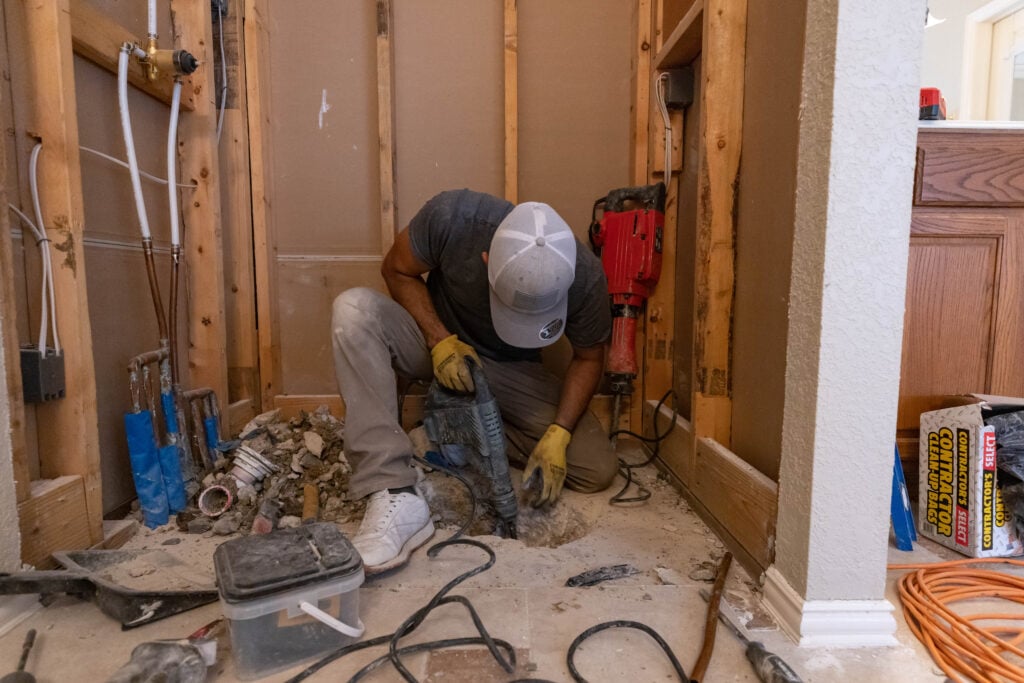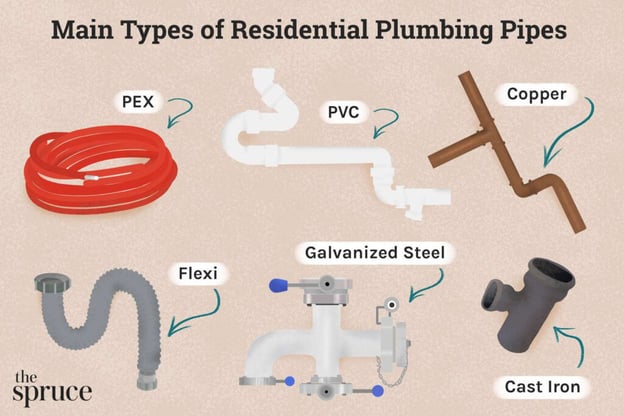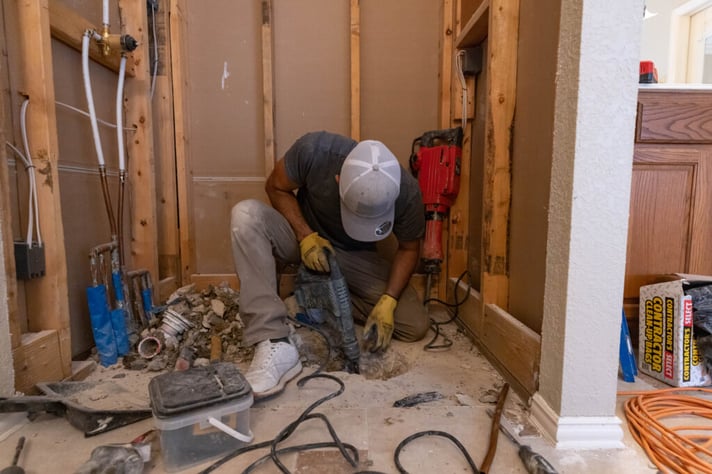What If My Home Has Old Plumbing? Will a Remodel Be a Hassle?
September 1st, 2025
5 min read
By Molly Ryan

You’d love to remodel your bathroom, but you have a sneaking suspicion that your plumbing is old enough that it needs to be replaced. In fact, you’re almost certain that any bathroom remodeler would insist that you invest in plumbing upgrades before installing any new fixtures or appliances. Is it really worth the hassle, or should you leave your bathroom alone?
At ZINTEX Remodeling, we’ve completed thousands of bathroom renovation projects throughout eleven different states. That means that we’ve worked on houses of all ages and have seen some seriously old pipes in the process. Read on to discover exactly what old plumbing means for your remodel and why it’s probably worth forging ahead.
Table of Contents
- When Is Plumbing Considered Old?
- How to Find Out How Old My Plumbing Is
- How Will Old Plumbing Impact My Remodel?
- Is It Worth the Hassle to Replace Old Plumbing?
- Learn More About Budgeting Your Remodel
When Is Plumbing Considered Old?
How do you know if your plumbing is actually old? It depends largely on the material your pipes are made from.
Older homes that haven’t undergone plumbing upgrades may still have metal pipes. For example, you might see galvanized steel in homes built before the 1960s, and copper in homes built in the 1970s. In older homes, you’ll also see different materials used for different purposes, like galvanized steel for potable water and cast iron for sewage.
| Type of plumbing | Average lifespan |
|---|---|
| Brass | 40 - 70 years |
| Copper | 50+ years |
| Galvanized steel | 20 - 50 years |
| Cast iron | 75 - 100 years |
| Polyvinyl chloride (PVC) and CPVC | 40 - 100 years |
| PEX | 50+ years |
Today’s homes are most likely to include at least some PVC and CPVC pipes, but as you can see, the average lifespan varies quite a bit. Early versions of PVC pipes weren’t nearly as durable as the enhanced PVC used in homes today. For example, if you’ve got the original PVC pipes from your 1960s home, it may be time to think about replacing them. However, if your PVC pipes were installed in the 21st century, they’re probably nowhere near the end of their lifespan.
PEX is another modern contender that can easily and affordably replace outdated materials like copper. It provides great high temperature-resistance, freeze-resistance, and corrosion-resistance. PEX often accompany PVC CPVC drain pipes to create complete, updated systems.

How to Find Out How Old My Plumbing Is
If you don’t know off the top of your head what material your pipes are made from or when those pipes were last updated, there are a few methods to find out more. These include:
- Reviewing property inspection records from when you purchased your home
- Requesting property records from your county, which may show any major upgrades (assuming the owner at the time secured permits)
- Consulting a professional plumber, bathroom remodeler, or home inspector
Age isn’t the only factor to take into consideration. You should also consider plumbing upgrades if you notice signs like:
- Low, worsening, or inconsistent water pressure
- Discolored water (unless you’re under a boil notice or use well water)
- Frequent problems with leaking or bursting pipes
- Poor water efficiency
How Will Old Plumbing Impact My Remodel?
There are two major ways in which old plumbing can impact your bathroom remodel. If you need to make significant updates to your plumbing, you’re probably looking at a longer remodel timeline and higher remodel costs.
Old Plumbing and Remodel Timelines
Let’s talk about the timeline first. A full bathroom remodel can take anywhere from three days to two weeks, not including lead times (the time between your consultation and the remodel actually starting). If you’re only upgrading a single bathroom feature, like your bathtub or shower, your timeline is likely one to three days.
Significant plumbing upgrades are what will put you on the longer side of that timeline, because you’ll need to remove, replace, and possibly reconfigure old pipes before installing any new features.

Old Plumbing and Remodel Costs
Plumbing and electrical upgrades tend to take up about 10-20% of a bathroom remodeling budget. In dollars, that’s usually somewhere between $1,200-$6,000. If you need permits for plumbing upgrades, that could be another $150-$1,200 (and a longer lead time while you wait for permits to come through).
Once again, significant plumbing upgrades may put you on the higher side of that range, although it really depends on how much of your plumbing you’ll replace during your remodel. For example, if all you’re doing is replacing your tub or shower, you’re not going to replace all of the plumbing in your bathroom during the scope of that remodel.
Is It Worth the Hassle to Replace Old Plumbing?
If you’ve got plumbing in your bathroom that we can officially call “old,” it’s almost definitely worth the hassle to replace it during your remodel. The benefits are a financial gift that keeps on giving, so let’s take a closer look.
Modern Plumbing Improves Home Efficiency
There’s no easy way to calculate how much waste old plumbing creates, but it certainly can’t compare to contemporary high-efficiency alternatives. For example, the EPA estimates that the average household’s leaks can yield 10,000 gallons of water waste every year. Your old pipes may also reduce efficiency thanks to:
❌ Poor pipe insulation: requires more energy output to heat your water
❌ Poor water pressure: requires more water usage for things like washing a dish or rinsing shampoo from your hair
❌ Incompatibility with high-efficiency appliances: keeps homeowners from saving up to $350 on water and electric bills each year by switching to WaterSense and ENERGY STAR appliances
By upgrading your bathroom plumbing, you can improve your home’s efficiency, cut down on water and energy waste, and even reduce your utility bills.
New Plumbing Means Lower Maintenance Costs
It may feel daunting to pay a few thousand dollars all at once to redo your plumbing, but how much does it cost to defer that process? The older your pipes get, the more repairs they may need. Worst case scenario, a pipe bursts, leaving you with some serious damage.
According to Angi, pipe leak repair costs an average of $500, while water damage restoration costs can reach over $6,000. Unfortunately, seriously old pipes can wreak this type of havoc more than once. By investing in plumbing upgrades, you’re paying for long-term improvements, rather than short-term solutions.
Plumbing Upgrades Make Your Home Market-Ready
New pipes are considered invisible upgrades, which don’t always get the same level of attention as visible remodels when it comes to ROI. That said, most experts can agree that old plumbing can hurt your property value in a couple of ways, including:
❌ Lower property valuation: appraisers will likely value your home at a lower price point if they see glaring issues with your plumbing
❌ More buyer concessions: even at a lower price point, buyers may push for a reduced purchase price or repair credits to cover the cost of repiping
❌ Smaller market: fewer buyers want to purchase a home that will require extensive repairs in the near future, meaning your home may sit on the market longer
While there is no clear-cut data regarding the increase in property value that new pipes yield, plumbing upgrades will eliminate these problems when you decide to sell your home.
Learn More About Budgeting Your Remodel
Now you know what to expect should you move forward with a bathroom remodel with old plumbing. You also know why it’s probably worth the investment to have that plumbing replaced. What’s next?
At ZINTEX, we know that cost is a major concern for most homeowners. Since you’re already looking at potential cost increases to address your outdated plumbing, what can you do to stay within your budget? Take a look at our guide to the cost of different shower wall materials.
FAQs About Plumbing During a Remodel
Q: Will I need to hire a separate plumber in addition to my bathroom remodeling contractor?
This depends on whether or not your contractor has a licensed plumber on their team and how extensive your plumbing replacement needs are. Oftentimes, our ZINTEX installers are able to complete any plumbing upgrades needed.
Q: Does my bathroom remodel financing cover the cost of plumbing upgrades?
Assuming that you are able to complete all plumbing upgrades as part of your bathroom remodel (as opposed to hiring a separate plumber or completing plumbing upgrades in advance), you’ll only receive one lump sum estimate. This means that you can use the same financing for your plumbing upgrades and your bathroom remodel.
Q: Can I remodel my bathroom without upgrading old plumbing?
It may be possible to make some improvements to your bathroom without upgrading old plumbing. However, some new fixtures and appliances won’t be compatible with old plumbing. Additionally, you’ll still face many of the pitfalls of having old plumbing, like high maintenance costs, even after your remodel is complete.
Molly Ryan is a professional writer with over 6 years of experience creating content for the home improvement industry. After receiving her MA in Literary and Cultural Studies from Carnegie Mellon University in 2019, Molly launched a freelance career specializing in real estate, home remodeling, and home financing. She hung up her freelance hat to join the ZINTEX team in early 2025, where she has developed an expertise for acrylic showers, bathroom accessibility, and home improvement ROI.
Topics:
